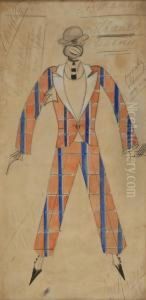Igor Terent'Ev Paintings
Igor Terent'ev was a Russian avant-garde poet, artist, and a key figure in the Dada movement within Russia. Born on October 13, 1902, in Tbilisi, Georgia, which was then part of the Russian Empire, Terent'ev was active during a tumultuous period in Russian history that saw the end of imperial rule and the establishment of the Soviet Union.
Terent'ev's early life and education remain somewhat obscure, but it is known that he developed an interest in the radical art movements of the time, such as Futurism, Constructivism, and Dada. His involvement with the avant-garde circles led him to engage with other prominent figures in Russian art and literature, including Ilia Zdanevich, known as Iliazd, with whom he would collaborate.
In 1919, Terent'ev moved to Petrograd (now St. Petersburg), where he became involved with the local artistic community and started to publish his poems. His work was characterized by an anarchic spirit and a rejection of traditional artistic and social norms, which was in line with the Dadaist ethos. Terent'ev's poetry often employed absurdism and a playful use of language, reflecting the chaotic nature of the era.
By the mid-1920s, the political climate in the Soviet Union became increasingly repressive towards avant-garde artists, as the government began to favor more realistic and state-sanctioned forms of art. This change in the cultural landscape led Terent'ev to move away from the Soviet Union. He settled in Paris in 1925, where he continued to engage with fellow émigré artists and participated in the international Dada movement.
Despite his contributions to the avant-garde, Terent'ev struggled with financial difficulties and remained relatively unknown during his lifetime. His work was often overshadowed by that of his contemporaries, and it wasn't until later in the 20th century that his contributions to the Russian avant-garde and Dada were reevaluated and recognized by scholars.
Tragically, Terent'ev's life was cut short when he was murdered in Paris on June 10, 1937, under mysterious circumstances. The exact details of his death remain unclear, but it was a loss to the world of avant-garde art. His legacy lives on through his poems and writings, which continue to be studied by those interested in the Russian avant-garde and the Dada movement.
